The End of an Obsession: A Review of “Castro’s Secrets”
 |
After almost half a century of conspiracy theories on the JFK assassination, a former CIA analyst and current research associate at the Institute of Cuban and Cuban-American Studies (ICCAS) at the University of Miami has accidentally given the conclusive evidence that Castro had nothing to do with Oswald or Kennedy’s death. In his latest book, Castro's Secrets (Palgrave Macmillan, 2012), Dr. Brian Latell insisted on unveiling a conspiracy of silence: Castro would have known in advance Oswald was going to kill Kennedy and chose to remain silent about it. Far from making even a circumstantial case against Castro, Dr. Latell actually paved the way for critical thinking which erases any cloud of suspicion.
The Comer Clark Allegation
Castro’s foreknowledge is an old story that was first broken by late British journalist Comer Clark. This was a story entitled “Fidel Castro Says He Knew of Oswald Threat to Kill JFK” (National Enquirer, London, October 15, 1967, pages 4-5). On July 9, 1967, Clark flew to Havana and tried to carry out an interview with Castro, but it was flatly denied. (note)
Nevertheless, Clark wrote that an impromptu interview had taken place anyway. It took place on a sidewalk at a pizzeria in front of a cheering crowd. The claim was that Castro told Clark,
“Yes,I heard of Lee Harvey Oswald’s plan to kill President Kennedy. It’s possible I could have saved him. I might have been able to, but I didn’t. I never believed the plan would be put into effect.”
Castro went on and explained that Oswald visited the Cuban Embassy in Mexico City twice. The second time he said something like: Someone ought to shoot that President Kennedy. Then Castro said,
“And this was exactly how it was reported to me; ‘Maybe I’ll try to do it.”
This was less than two months before the American President was assassinated. The House Select Committee on Assassinations (HSCA) contacted Fidel about this accusation. On April 3, 1978, he replied that since he never went to public restaurants, the man must have invented the story.
Congressman Christopher Dodd (D/Connecticut) stressed that it was ridiculous that the head of a country would give a print interview in a pizzeria. (HCSA Report, Volume III, pages 207-09). Dodd could have further added that he would never do so in a crowd and certainly not about such a sensitive matter.
Anthony Summers further undermined the Clark tale. He discovered that Clark, who was now deceased, had a reputation for selling sensational and sometimes spurious stories. When Summers talked to Clark's widow, she said that he never mentioned such an interview to her. Beyond that, Nina Gadd, Clark’s secretary, said that it was she who originated the story, even though she had never even been to Cuba. Gadd supposedly did this based not upon Clark, but what she heard from a Latin American foreign minister. (Summers, Conspiracy, p. 364)
Nevertheless, the Final Report of HSCA (U.S. Government Printing Office, 1979, page 122) said that the substance of Clark’s interview with Castro had been independently reported to the U.S. Government by a highly confidential and reliable source: Oswald had indeed vowed in the presence of Cuban consulate officials to assassinate the President. But further investigation led the HSCA to believe that Oswald did not voice such a threat to Cuban officials, and however reliable the confidential source may be, it would be in error in this instance.
The Jack Childs report
Although Chief Counsel Robert Blakey would not reveal who the source was, it turned out to be Jakob “Jack” Childs, codenamed NY 694-S by the FBI. Jack had engaged with his brother Morris in the Operation SOLO (1958-77). Their mission was to infiltrate the Communist Party of the United States (CPUSA), in order to gather intelligence about its relations with the USSR and other communist regimes. On May 20, 1964, Jack Childs flew from Moscow to a beach in Cuba on the SOLO Mission 15. He allegedly spent ten days there and was able to talk with Castro about the JFK assassination.
Childs reported to FBI Director J. Edgar Hoover that Castro received the information about Oswald’s appearance at the Cuban Embassy in Mexico in an oral report from “his diplomats” in the Embassy. (John Newman, Oswald and the CIA, p. 428) According to Childs, Castro was told about this immediately:
˜I was told this by my people in the Embassy exactly how he (Oswald) stalked in and walked in and ran out. That in itself was a suspicious movement, because nobody comes to an Embassy for a visa (they go to a Consulate). [Castro] stated that when Oswald was refused his visa at the Cuban Embassy in Mexico City, he acted like a madman and started yelling and shouting on his way out, 'I’m going to kill this bastard. I’m going to kill Kennedy.’ [Castro] was speaking on the basis of facts given to him by his embassy personnel, who dealt with Oswald, and apparently had made a full, detailed report to Castro after President Kennedy was assassinated.” (FBI Records: The Vault - SOLO, http://vault.fbi.gov/solo. See part 63, pgs. 58-59).
The old sleuth Hoover summed up to Warren Commission General Counsel, James Lee Rankin, on June 17, 1964: The information furnished by our source at this time as having come from Castro is consistent with and substantially the same as that which appears in Castro’s speech of November 27, 1963. No further action is contemplated by this Bureau. (Warren Commission Document 1359).
The Latell Report
In the June 2012 edition of the electronic newsletter, The Latell Report, published by the ICCAS-UM , Dr. Latell summed up: Childs learned that Castro received the information about Oswald’s appearances at the Cuban embassy, because he was told about it immediately. Fidel spoke to Childs on the basis of facts given to him by his embassy personnel, who dealt with Oswald, and apparently made a full, detailed report. By trimming the phrase “after President Kennedy was assassinated” from the Childs report, Dr. Latell turned this alibi into a smoking gun against Castro, who had denied any foreknowledge of Oswald in both his speech at the University of Havana on November 27, 1963, and his Radio/TV appearance on November 23, 1963.
Dr. Latell boasts about catching Castro in a lie, but only by keeping hidden the actual time ”after President Kennedy was assassinated” in which Castro knew about Oswald. Childs also tapers the story by furnishing the exact location of the Oswald outburst: the Cuban embassy, not the consulate, located in a separate building. The Lopez Report [a.k.a. "Oswald, the CIA, and Mexico City", 1978] actually states that the CIA photographed the visitors to the Cuban diplomatic compound from two different windows in a third floor apartment at 149 Francisco Marquez Street (see pages 12 ff.) because the entrance to the embassy was on the corner of Tacubaya Alley and the entrance to the consulate, on the corner of Zamora Street.
Moreover Childs came to the foregone conclusion that Castro had nothing to with the assassination. After discussing his statements with Beatrice Johnson, the CPUSA representative in Cuba, Childs and Johnson decided never to talk again about the issue because it was dynamite. Hoover took it seriously, but Dr. Latell does not. He dared to manipulate time and location for making his point, and no wonder the issue exploded in his hands.
The HSCA’s Sound Judgment
Unaware of the actual circumstances, the least the HSCA could do was discard that Oswald voiced threat to Cuban officials. Why? Because both the outgoing and incoming Cuban consuls in Mexico City, Eusebio Azcue and Alfredo Mirabal, testified (HCSA Report, Volume III, pages 127-58 and 173-78, respectively) that they did not recall hearing Oswald threatening Kennedy’s life while dealing with him about an in-transit Cuban visa to go to the Soviet Union. Neither did the Mexican employee Silvia Duran (JFK Exhibit F-440A), who attended Oswald three times on the same day, September 27, 1963, regarding his visa application (JFK Exhibit F-408).
Based only on newspapers, Castro knew that the HSCA—especially the authors of the Mexico City report, Ed Lopez and Dan Hardway—had extensive information about phone conversations in Mexico City. Azcue and Mirabal were forced to truthfully testify to avoid being potentially caught in a lie at a public hearing in the United States. And one will search in vain for any such threats in the transcripts declassified today in the Lopez Report.
As Newman writes, the problem with the Childs Report as issued to Hoover is that there is no specificity in it: Who were the diplomats who heard this threat? On what day was it made? How was it communicated from Mexico City to Havana? And how could the CIA not have known about it with all their audio surveillance installed? (Newman, p. 428) But beyond that, in a private interview Newman gave to Jim DiEugenio in San Francisco, the former intelligence analyst showed him the actual Childs report as given to Hoover. Newman told DiEugenio that, because he had seen hundreds of such informant reports, he could tell by the formatting that it was a forgery.
The First Defector
For disputing HSCA logic discounting Childs, Dr. Latell resorts to defectors from the Castro General Directorate of Intelligence (acronym DGI in Spanish). The first one, Vladimir Rodriguez-Lahera, would have told the CIA that Castro lied when he publicly denied any knowledge of Oswald. The legend says Vladimir defected to Canada around April 24, 1964, and the CIA codenamed him AMMUG-1.
His debriefing (RIF 104-10400-10118) included that "the only possible fabrication known by this source was the specific denial by Fidel Castro on a television program [November 23, 1963], of any Cuban knowledge of Oswald." For turning the possible fabrication into evidence, Dr. Latell swallows AMMUG-1, saying that the most routine matters at the Cuban diplomatic compound in Mexico City were reported directly to Castro. This author begs to disagree. Neither Castro nor any other Chief of Government has time for being informed about visa applications or nasty applicants.
By May 8, 1964, the CIA realized AMMUG-1 didn’t know what he was talking about. He ended up admitting: "I have no personal knowledge of Lee Harvey Oswald or his activities." His CIA handler wrote: "The source does not claim to have any significant information concerning the assassination of President Kennedy or about the activities of Oswald." Even so, Dr. Latell keeps on agonizing about an AMMUG-1 report that Oswald was in contact with DGI officers before, during and after his visits to the Cuban consulate.
AMMUG-1 did not give the slightest conjecture about after. In regards to ‘during’ the Mexico City trip, he stated that senior intelligence officer Manuel Vega mentioned that Oswald had gone to the Cuban consulate two or three times in connection with a visa. AMMUG-1 didn’t recall anything else about Oswald contacting DGI officers, but added: he felt sure that he would have done so because Vega had said that Oswald had returned several times and [it was] the usual procedure [for] expediting the granting of visas to DGI agents: if the visa applicant does not utter indicative phrases, the DGI officers tell the applicant to return in a few days. This house of cards falls down not only because Oswald came three times on the same day to the Cuban embassy. (See Warren Report, p. 734-35, below) But AMMUG-1 felt sure there was a contact during under the premise that Oswald was a DGI agent. This implies a contact before, but at this point AMMUG-1 became entirely pointless.
CLICK ON IMAGES TO ENGLARGE
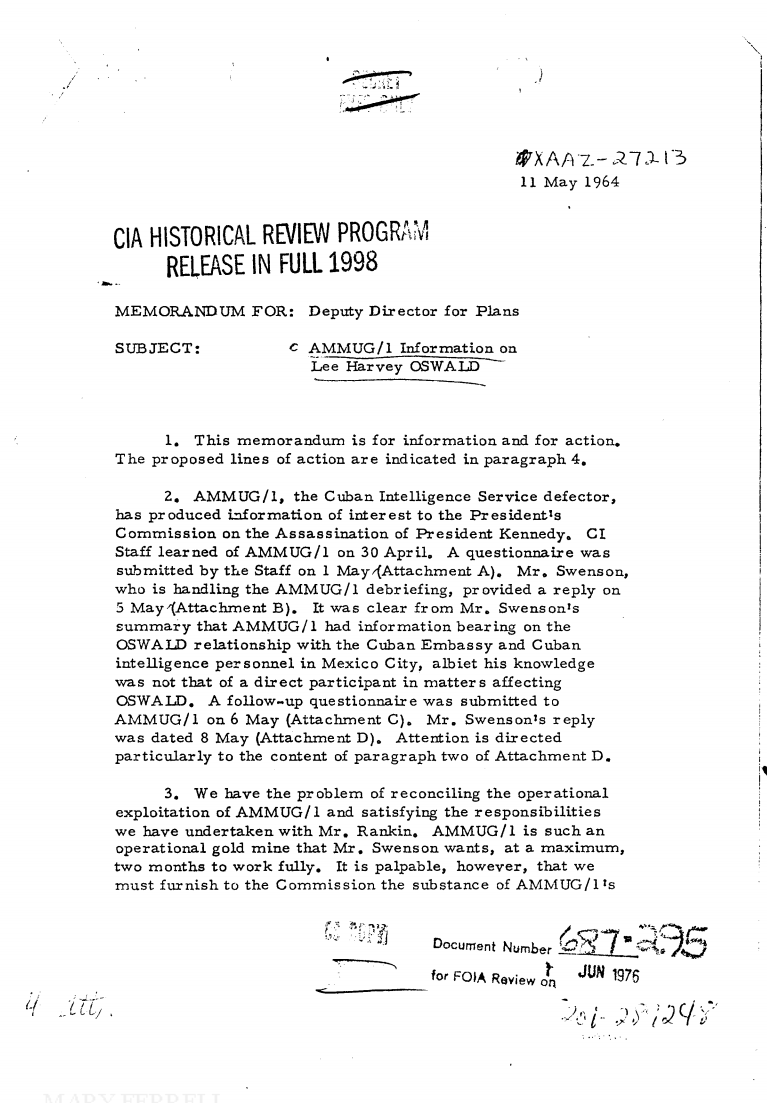 | 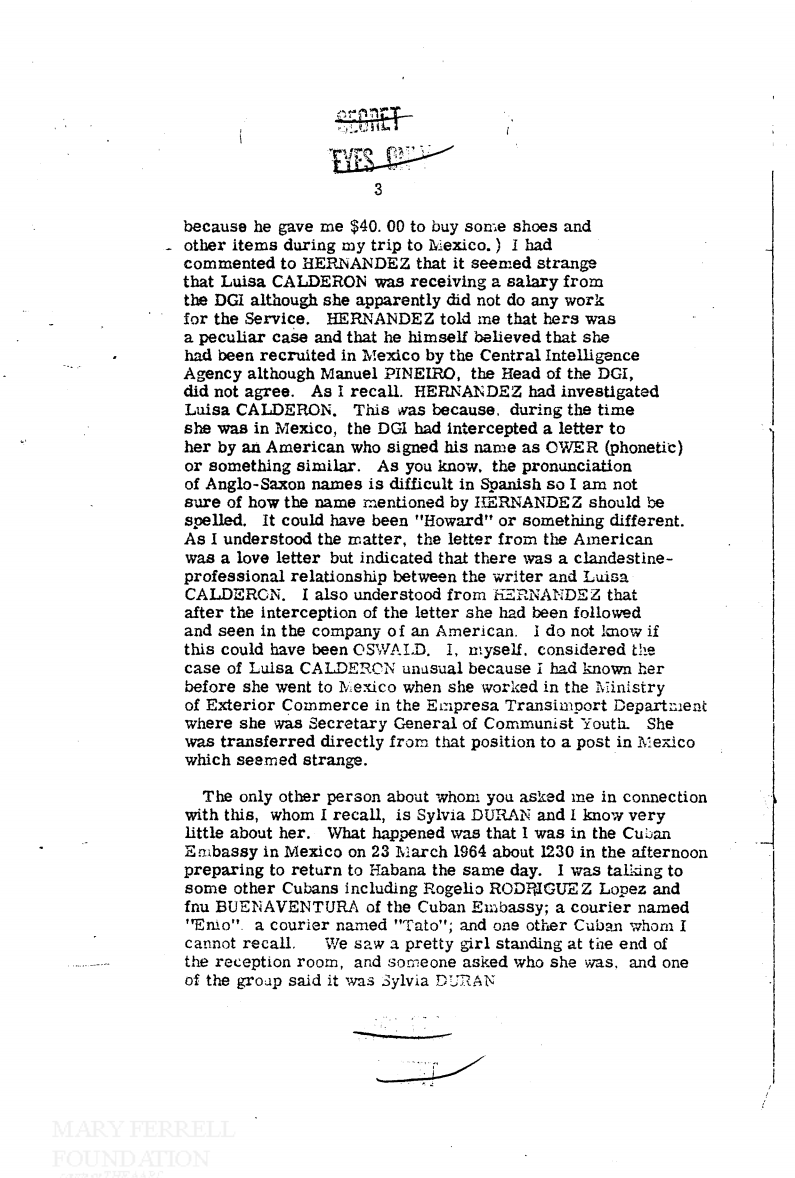 | 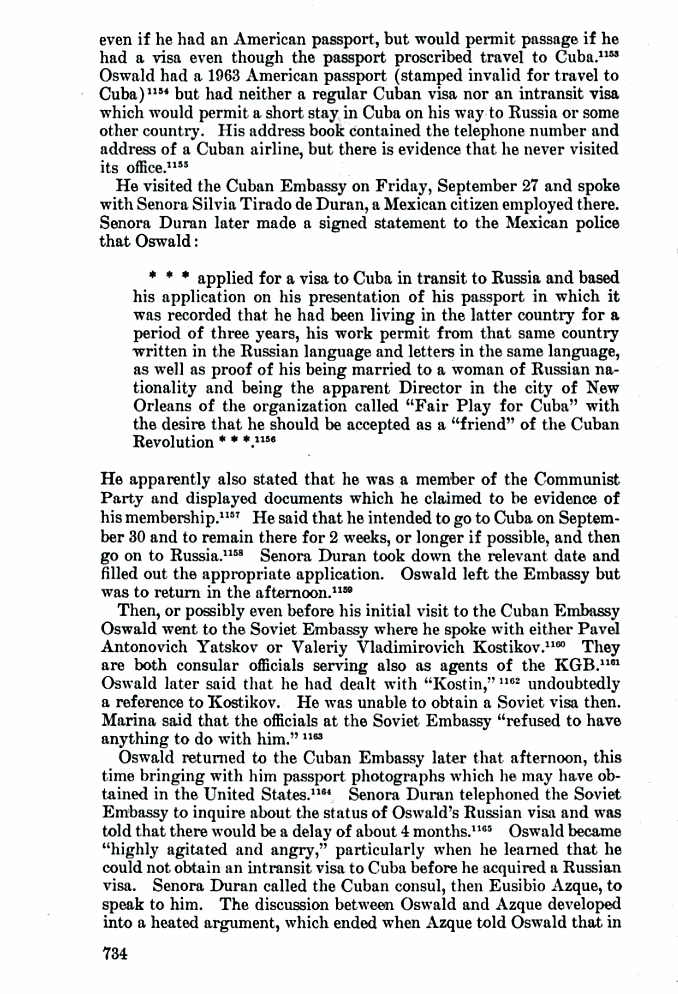 | ||
AMMUG-1 page 1 | AMMUG-1 page 3 | WR page 734 | ||
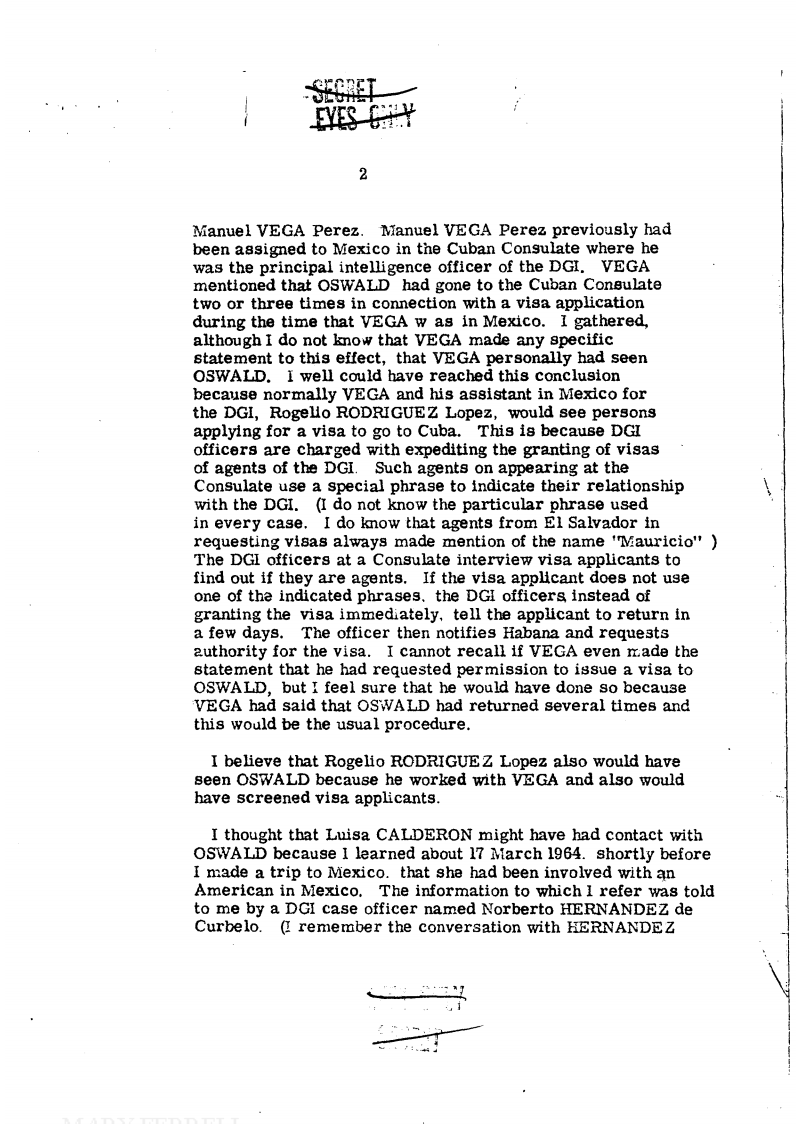 | 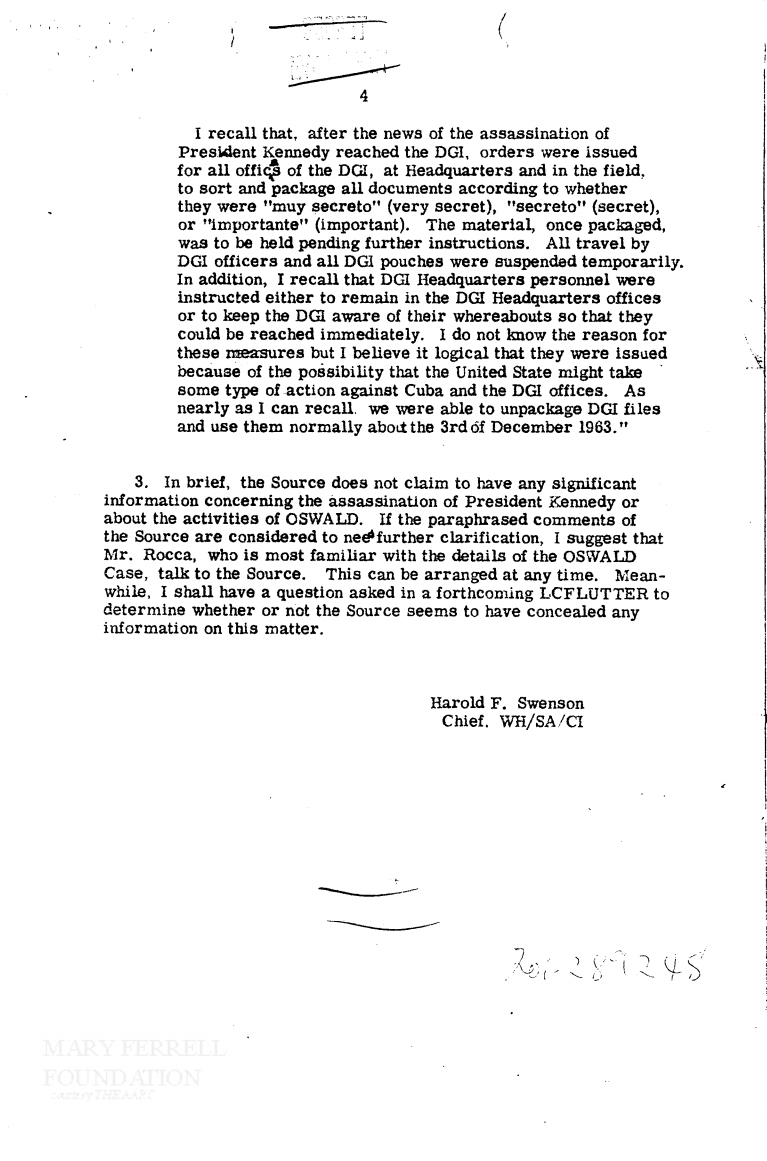 | 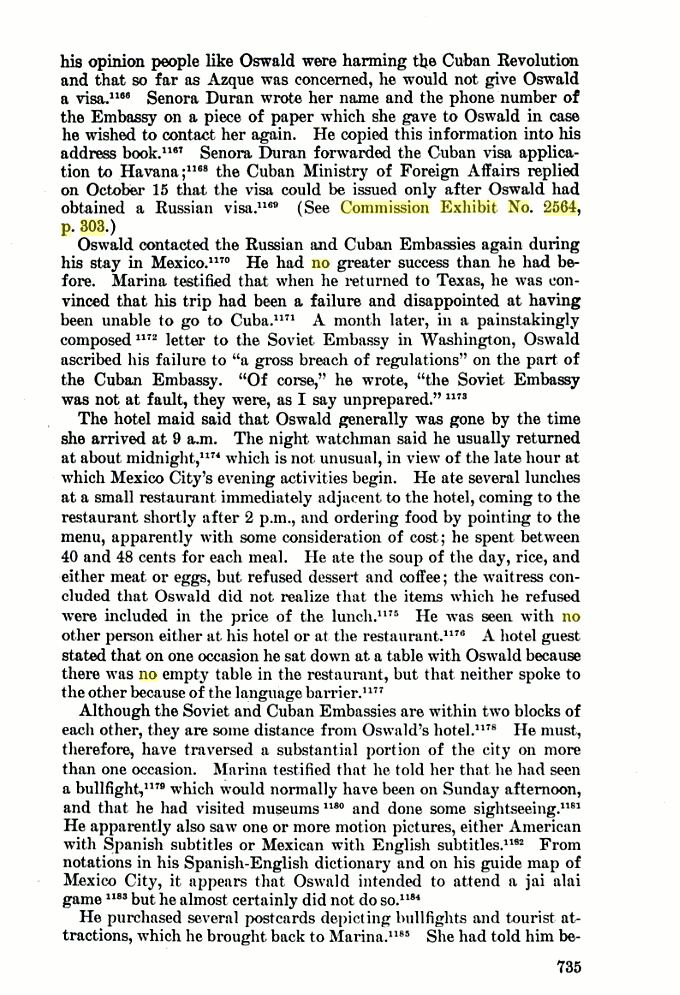 | ||
AMMUG-2 page 1 | AMMUG-3 page 3 | WR page 735 | ||
He said that he thought that Luisa Calderon might have had contact with Oswald because he learned about 17 March 1964, that she had been involved with an American in Mexico. (The DGI had intercepted a letter to her by an American who signed his name as Ower, phonetic, or something similar. He said she had been followed and seen in the company of an American. He did not know if this could have been Oswald.)
The problem with this is that the Calderon story today is a non-sequitir. If one is not familiar with it, it goes like this: Luisa was a Cuban Embassy employee who was heard on a tapped phone line saying words that were translated as, “I knew almost before Kennedy.” As Rex Bradford pointed out, in the 70’s this became a teaser for, “Did she have foreknowledge of the assassination?” The HSCA could not interview Luisa. But with AMMUG-1 saying to the CIA in 1964 that Oswald may have met with Calderon in 1963 during visits prior to the September-October journey, Luisa’s story now grew even heavier with suspicion.
As Bradford notes, this call was intercepted at 5:30 PM. So the question becomes: "Were there any other calls previous to this where Luisa could have heard of the assassination?" It turns out there were two such calls. In the first one, captured at 1: 30, she expressed surprise on hearing the news of Kennedy’s death, and she said she did not believe it and asked who did it. As Bradford notes on his Luisa Calderon page at Mary Ferrell Foundation, it is odd that the CIA apparently did not show this other transcript to the HSCA to settle the matter once and for all.
Neither Calderon nor Mirabal led to Dr. Latell’s suggestion that the DGI was acquainted with Oswald and had started a file on him when he was a Marine stationed (December 22, 1958 - September 11, 1959) in California. The specific account on Oswald attempting to get in with Castroite consular officials in Los Angeles in early 1959 suggests quite the contrary. Former marine (1954-58), Castroite pilot (1959-60) and anti-Castro soldier of fortune (1960-62) Gerald Patrick Hemming stated that he thought Oswald might have been on the Naval Intelligence payroll. “You know, a penetrator. I told the [Castroite] leadership to get rid of him. (Dick Russell, The Man Who Knew Too Much: Hired to Kill Oswald and Prevent the Assassination of JFK, Carroll & Graf, 1992, page 178).
The Most Valuable Defector
The last straw in Dr. Latell’s unveiling of a conspiracy of silence is a classic non sequitur fallacy slipped by Major Florentino Aspillaga, a Castro intelligence officer until the year 1985 who defected from Czechoslovakia to Austria in June, 1987. Being hardly 16 years old, Aspillaga already had the standing assignment of electronically detecting CIA agents and infiltration teams. On November 22, 1963, he got an unprecedented order around 9:00 or 9:30 am EST: "Listen to any small detail from Texas." At 1:40 pm EST, CBS anchor Walter Cronkite broke the news in Dallas, Texas: three shots were fired at President Kennedy's motorcade. Aspillaga drew the conclusion: Castro knew Kennedy would be killed.
Whatever the reason Castro would have had to give the order, the most unlikely is some foreknowledge about Oswald’s intention to shoot Kennedy, because it would imply that Castro must have been sure about Oswald’s whereabouts on November 22, 1963. The well-known, and quite eventful journey of Oswald makes such foreknowledge by Castro highly improbable. Shortly before Oswald left New Orleans for Mexico City, his wife Marina Oswald (nee Prusakova) had moved to Irving, about 17 miles from Dallas, for the birth of their second child. She stayed at her friend Ruth Paine’s home. Oswald came back from Mexico City on October 2, 1963, when nobody, including God and the CIA, knew whether he would still be in Dallas or elsewhere by the time of the “still in the talking stage” JFK visit. Oswald arrived in Dallas on October 3, 1963, and checked in at the YMCA. The day before, the FBI Field Office in New Orleans was tasking Dallas, Fort Worth, and even Malvern (Arkansas) for ascertaining Oswald’s whereabouts.
After failing to get hired at Padgett Printing in Dallas, Oswald hitchhiked to Ruth Paine's house in Irving. He returned to Dallas on October 7, 1963, but couldn’t get a job again and went again to Irving on October 12. He came back to Dallas on October 14. As Ruth Paine mentioned that he was having trouble finding work, her neighbor Linnie Mae Randle hinted about an opening at the Texas School Book Depository (TSBD), where her brother Buell Frazier was employed. Paine called Oswald and he began to work at the TSBD on October 16, 1963.
Apart from the strange order to use intelligence resources for knowing details that will be surely available by listening to the commercial radio, Aspillaga’s credibility is as weak as his reasoning. He told Dr. Latell that he had previously given the information about that order only to the CIA in 1987. Then it must be fully explained why the CIA didn’t come forward with Aspillaga to the Assassination Records Review Board (ARRB), which gathered records from 1994 to 1998 after the fireworks made by Oliver Stone with his film JFK (1991). It also makes everyone wonder why Aspillaga abstained from revealing the issue to the media. In June 1988, for instance, he referred to Castro 69 times during a radio interview with Tomas Regalado in Miami, but not even once to Kennedy.
Dr. Latell wrote in his book he owes a special debt of gratitude to Aspillaga. But both have put themselves in a delicate spot with an anecdote delivered a la carte 25 years later for connecting Castro to Oswald. Dr. Latell abjures social science by messing around with DGI defectors, despite his own foreknowledge about the methodological circumstance that their tales couldn’t be compared with Castro’s archives. The blame is not on Castro for shielding them from outsiders, but on Dr. Latell, since he used the creative imagination of Cuban defectors for writing a non-fiction book instead of a novel about the JFK assassination.
Note: typically meant wiretaps. (back)
Note: HSCA Interview of Fidel Castro (back)
Note: Link to MFF file. (back)



